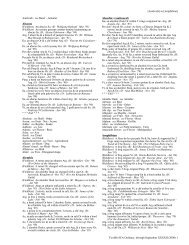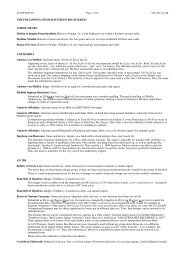You also want an ePaper? Increase the reach of your titles
YUMPU automatically turns print PDFs into web optimized ePapers that Google loves.
RETURNS Page 16 of 20 February 2010 LoAR<br />
ATENVELDT<br />
effectively cattail plants. The exact number of cattails on a plant may be blazonable but is not worth<br />
difference. This also conflicts with ... Vert, three cattails slipped and leaved conjo<strong>in</strong>ed at the base argent.<br />
That armory also appears to be a s<strong>in</strong>gle cattail plant, result<strong>in</strong>g <strong>in</strong> a similar analysis. [Iron Bog, Shire of,<br />
05/02, R-East]<br />
This means that a plant with multiple cattails conflict with a plant with a different number of (multiple) cattails.<br />
However, a s<strong>in</strong>gle wheat stalk is a period charge, as <strong>in</strong> the arms of Trigueros, <strong>in</strong> the Libra da Nobreza, f. xxxvi and<br />
no evidence has been presented that a s<strong>in</strong>gle stalk of wheat is <strong>in</strong>terchangeable with cattails. Therefore, a s<strong>in</strong>gle stalk<br />
of wheat has a CD from a plant with two or more cattails and Vivien’s device is clear of the barony’s badge. [Vivien<br />
of Shaftesbury, 10/05, A-An Tir]<br />
Apply<strong>in</strong>g the same logic to wheat stalks, this device is returned for conflict with a badge of the Shire of Ambergard, Gules, a<br />
stalk of wheat with<strong>in</strong> a bordure Or. There is no CD for the change of the number of ears of wheat on the stalk, yield<strong>in</strong>g a s<strong>in</strong>gle<br />
CD for the change of t<strong>in</strong>cture of the field.<br />
This device is clear of the badge of the Barony of Sa<strong>in</strong>t Swith<strong>in</strong>’s Bog, Sable, a stalk of three cattails slipped and leaved, a<br />
bordure Or. Wheat stalks and cattails are period charges. We have no evidence that period heralds considered them<br />
<strong>in</strong>terchangeable. Therefore, by the previous precedent, there is a CD for the difference between a stalk of three cattails and a<br />
stalk of three heads of wheat and there is another CD for the change of t<strong>in</strong>cture of the field.<br />
Bjorn Bloodax. Name.<br />
This name is returned for lack of documentation for the spell<strong>in</strong>g Bjorn. The given name was cited from Geirr Bassi<br />
Haraldsson, The Old Norse Name, but the form of the name documented there is Bj{o,}rn. As precedent notes, "In old Norse, o<br />
and {o,} are not <strong>in</strong>terchangeable" [Bj{o,}rn the Hunter, LoAR 07/2009, Meridies-A]. L<strong>in</strong>d, Norsk-Isländska Dopnamn ock<br />
F<strong>in</strong>gerade Namn fran Medeltiden, s.n. Bi{o,}rn shows several examples of Biorn, one of which dates to 1334, but no examples<br />
of Bjorn. We would change the name to either Bj{o,}rn or Biorn, but the submitter does not allow any changes, so we are<br />
forced to return this name.<br />
The byname Bloodax is a L<strong>in</strong>gua Anglica form of Old Norse blóðøx.<br />
His device has been registered under the hold<strong>in</strong>g name Kenneth Bloodax.<br />
Kali Amman. Name.<br />
This name is returned for presumption, as it is a name of the goddess Kali, known variously <strong>in</strong> Tamil as Kali Mata, Kali Ma,<br />
and Kali Amman.<br />
Sufficient evidence was found to give the submitter the benefit of the doubt that Kali may have been used as a human name <strong>in</strong><br />
India <strong>in</strong> period. However, when comb<strong>in</strong>ed with the byname Amman, the submitted name becomes presumptuous of the<br />
goddess as Kali Amman is identical to one of the names used for this goddess. Therefore, this name must be returned.<br />
The comb<strong>in</strong>ation of articles used to document this name resulted <strong>in</strong> a temporal disparity issue. We want to make the submitter<br />
aware of this factor to help with any resubmission.<br />
The given name was documented from the article "Female Chola Names". Metron Ariston provided the summary:<br />
The article entitled "Female Chola Names" at<br />
http://sites.google.com/site/vairavisca/Home/creations/<strong>in</strong>dian-name-research conta<strong>in</strong>s material from pre-1400<br />
<strong>in</strong>scriptions at Chola with dates that very clearly go back as early as the n<strong>in</strong>th century with the bulk of the names I<br />
looked at be<strong>in</strong>g from the twelfth century and before. The <strong>in</strong>troduction to the article states that most names are Tamil<br />
or Tamilized Sanskrit with a very few Sanskrit forms.<br />
The byname was documented from Tangwystyl verch Morgant Glasvryn’s article "Women’s Names from (Mostly) 16th<br />
Century Inscriptions at Tirupati (India)". Tangwystyl says <strong>in</strong> this article that "the names appear to be classical Sanskrit". Siren<br />
expla<strong>in</strong>s, "By this time, Sanskrit is a dead "language of record" like medieval Lat<strong>in</strong>. Thus, I’d describe the names as<br />
"Sanskritized Tamil" rather than the other way around. The 16th c. names seem likely to also be Sanskritized Tamil" [...] or<br />
possibly Telegu".<br />
Therefore, if a given name is documented from the first article and a byname is documented from the second, the name as a<br />
whole could easily have elements that are dated more than 300 years apart, which is a step from period practice. With a s<strong>in</strong>gle<br />
step from period practice, a name is registerable. However, any additional step from period practice (such as one for l<strong>in</strong>guistic<br />
mix), is cause for return of the name.<br />
His device was registered under the hold<strong>in</strong>g name Kali of Atenveldt.<br />
Ragnarr Lefthand. Device. Per saltire gules and sable, an axe head Or.<br />
This item is be<strong>in</strong>g returned for unrecognizability of the primary charge. Section VII.7.A says that "Items must be recognizable<br />
solely from their appearance." Guesses on the identity of the primary charge varied from axe head to air horn to trumpet to<br />
cannon. While it is similar to some axe heads found as artifacts from period, it is not recognizable as any particular type of<br />
charge.<br />
ATLANTIA<br />
None.<br />
CAID<br />
Caid, K<strong>in</strong>gdom of. Badge for the Order of the Crescent and Flame. Azure, a flame Or issuant from a crescent with<strong>in</strong> a bordure<br />
embattled argent.











